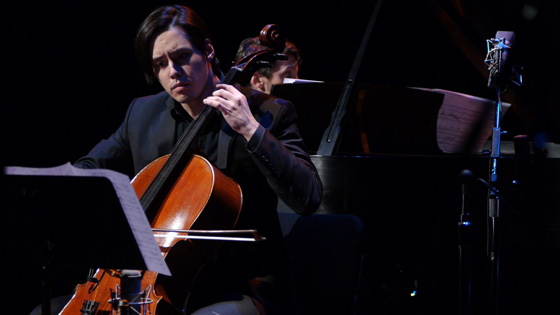Our (fairly) regular roundup of Music & Arts related news from Chicago-based web media, featuring thoughts and insight from some of the city’s most dedicated writers.
- Review: ICE plays John Zorn @ MCA

Michael Nicolas (cello) and Cory Smythe (piano) perform John Zorn’s ‘Occam’s Razor’As I settled in to my seat, eager for the International Contemporary Ensemble (ICE) to begin their performance of a half-dozen compositions by John Zorn at the MCA, I thought about the years I’ve spent listening to John Zorn’s records, both written and improvised, wondering what these through-written pieces would sound like, when suddenly, out of the corner of my eye, I spotted a familiar site. A man dressed in a very familiar pair of camouflage cargo pants and a zippered hoodie popped out of a side door to have a quick glance at the stage. The most comfortably-dressed man in modern composition was here tonight! It added a hot spark to the anticipation knowing that Zorn himself would be watching from the wings.
Considering the breadth (and, in many cases, extremity) of Zorn’s work, I came in expecting ear-bleed and grinding teeth from start to finish, but was surprised to hear not just his tender side, but also his beautifully classicist nature. The opening piece, a work for solo clarinet based on Herman Hesse’s novel “Steppenwolf,” was a long, lyrical work that sounded like the 1930s as inhabited by early modernist pioneers like Charles Ives and Henry Cowell, using abstraction as a way to color the mind and the mood, building to a dazzling sequence where clarinetist Joshua Rubin cleared intervallic jumps like he was playing hopscotch. To use Anthony Braxton’s terminology, the gravallic weight of this piece was off the charts. The fireworks evoked, however, never overpowered the sheer lyrical beauty of the composition and Rubin’s masterful handling of it.
The follow-up, titled “Occam’s Razor,” was scored for cello and piano. It wasn’t just the finest ICE piece I’ve witnessed, nor the best Zorn composition, but some of the most amazing music I’ve ever heard. The playing was fluid, like liquid clouds barreling through keyholes, with lots of start/stop moments that gave the piece the feeling of breathing. The thought of some of James Tenney’s works for cello and piano passed through my mind a few times, but the piece was all Zorn’s, navigating lurches of tempo and tone with a sure hand, creating a work that transcended abstraction, subversion of “conventional” music concepts, and other off-putting tags to present something that seemed to radiate pure beauty, the kind that doesn’t require a lengthy description in a program.
“The Tempest,” a work written for ICE and scored for flute, clarinet/bass clarinet, and drum set, gave each performer a character from Shakespeare’s play, though flautist Claire Chase coyly told the audience that we’d have to figure out for ourselves who was who. My notes simply say, “Power! Thunder! SOREY!” Because as great as flautist Claire Chase and clarinetist Rubin played, drummer Tyshawn Sorey held the audience rapt, guiding the difficult piece through a dozen or more changes of tone and intensity, one moment a disciplinarian marching band conductor, the next a rock god of thunder.
2004’s “Walpurgistnacht,” for string trio, contained playing so telepathic and mobile, the melodic lines shot like firing neurons from player to player, as if the trio was a large, single stringed instrument.
While the group set up, both Clare Chase and John Zorn talked with the audience. In regards to 1972’s “Canon to Stravinsky,” written in the year of Stravinsky’s death, Zorn explained, rather surprisingly, that “everyone was writing canons around that time!” (A side of 1972 few of us remember…) Though short, the fun and funny little piece really did feel like Stravinsky in all the best ways, especially in the work of ICE’s rock-star bassoonist Rebekah Heller. Can’t have Stravinsky without a bassoon!
The piece with the most instruments was the three-part “Baudelaires,” scored for flute/bass flute, bass clarinet, bassoon, harpsichord, guitar, violin, viola, and cello. This extraordinary piece was full of language-like phrasing, as if the group was translating Baudelaire’s words into pure song. Musical phrases lilted up at the end like questions or plugged into you like a blurted curse. The harpsichord always adds an interesting timbre to new music, sounding here more like a ’50s-vintage computer crunching data than the plaything of wig-powdered aristocrats. There was enormous timbral variety in the piece (each part was based on a different Baudelaire work), and each member made their brilliance known throughout the piece, whether it was a creative rake of Dan Lippel’s guitar or Nicolas’ gliding cello.
Zorn thanked ICE profusely, saying “I’ve come to realize that music is all about people. If you work with passionate, wonderful people, the music will always be the best you could hope for it.” After minutes of applause from the audience, Zorn returned with his trademark alto sax and Sorey in tow. The two commenced to strafe the audience with a short, wooly improv that was wholly welcome to audience members who knew about Zorn’s Mr. Hyde side.
Three cheers to ICE and John Zorn for one of the best nights of music I’ve seen in a very long time.
- Music Video Of The Day: Gylne Tider ‘Let It Be’
Here comes a weird trip as you head out the office door. [ more › ]
- Eyeworks Animation Festival Doesn’t Sit Still In Its Fourth Year
This Saturday the fourth incarnation of one of our favorite film events—the Eyeworks Festival of Experimental Animation—adopts a leaner, one-day program for the festival. [ more › ]
Digest powered by RSS Digest

